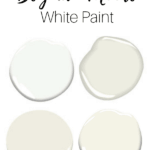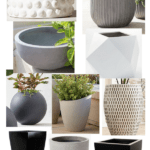Looking to add plants to your home decor but aren’t the best at keeping plants alive? I have put together a list of the best Indoor Air Purifying plants that can live in low light, beginner friendly, and easy to grow.

Air Pollutants in the air
When we think of pollution, we often think of common outdoor pollutants like smog from the Ozone layer or urban air pollutants from car exhausts and power plants. Many of these air pollutants can irritate or cause certain health conditions such as asthma and other respiratory symptoms (coughing, wheezing, or difficulty breathing).
When we think of indoor air pollution, we probably think of things like carbon monoxide, radon, and even things like second hand smoke and mold. But there are actually a lot of other air pollutants that affect us right inside our homes and many of us don’t even realize it!
Types of Indoor Air Pollutants
Volatile organic compounds, or VOC’s, are chemicals used in household products that are released into the air by off-gases. Formaldehyde is commonly found in lots of products like household cleaners, toilet paper, paints and varnishes, plywood, and carpeting. It is even emitted in small amounts from gas stoves. Xylene is used as a solvent in the printing, rubber, paint and leather industries. We breathe benzene indoors as a result of household cleaners, paints, furniture and carpeting. Trichloroethylene is used in things like paint removers and strippers, adhesives, spot removers, and rug-cleaning products.
nasa Clean Air Study

Now I don’t want you to get freaked out by the amount of potential air pollutants in your homes! We are not all doomed. There is one thing we can all do to help improve our home air quality…and that’s indoor plants.
Houseplants are natural indoor air cleaners. NASA actually did their Clean Air Study to determine what plants cleaned the air in there space stations the best. In this study, researchers discovered several breeds of plants that were able to effectively remove benzene, formaldehyde, and trichloroethylene, xylene, and ammonia from the air—chemicals that have been linked to health effects like headaches and eye irritation. That’s amazing!
So how do plants clean the air?
Pollutants in the air are absorbed through the plant’s stomata (microscopic openings in the leaves). They travel through the plant down to the root zone. Root microbes biodegrade the pollutants into food for the microbes and the plant. Water vapor is then released back into the air through transpiration.
I personally am not the best at taking care of indoor plants. I have a history of killing them all! But what I learned is that you have to pick “the right” indoor plant for your home. There are many air purifying plants that can survive indoors, are low maintenance and can handle low light conditions. I recently went plant crazy and bought a few from this list and they are all alive and well! Yay!
Check out my list below:
11 best low light air purifying indoor plants
1. Boston Fern (Nephrolepis exaltata)

Facts:
- Removes formaldehyde, xylene, and toluene from the air
- Thrives in moderate, indirect sunlight; high humidity
- Great for hanging basket or planter on a pedestal or atop a shelf
Experts say they are well worth the maintenance because of their air-purifying abilities. Boston fern’s remove more formaldehyde than any other plant. They also remove pollutants from car exhaust that might enter a home from an attached garage.
When growing a Boston fern indoors, it’s a good idea to provide additional humidity for them, especially during winter. You can create higher humidity by running an air humidifier or by placing a tray with water and stones nearby.
2. Spider Plant (Chlorophytum comosum)
Facts:
- Removes formaldehyde, xylene, and toluene from the air
- Thrives in moderate, indirect sunlight; cooler temperatures
- A great houseplant for propagating!
This plant loves indirect light and doesn’t require much attention. The Spider Plant is very forgiving to various living conditions, is an excellent starter plant for newbies, and easy to grow. Just make sure the soil is dry in between watering.
3. Pothos (Epipremnum aureum)

Facts:
- Removes benzene, formaldehyde, xylene, and toluene from the air
- Thrives in moderate to low indirect sunlight.
- Nicknamed “the cubicle plant” for its ability to grow in less-than-ideal environments.
Often called Devil’s Ivy or Golden Pothos, this a popular houseplant because it not only looks good as a home decor piece, but is also easy to care for. It has evergreen vines and small green heart shaped leaves with yellowish-white hues, often sold in decorative hanging baskets. I found mine at Lowes but have also seen it at Home Depot and other nursery stores.
Just be careful if you have pets. If digested by your dog or cat, it could cause vomiting and other health issues.
4. Peace Lily (Spathiphyllum ‘Mauna Loa’)
Facts:
- Removes benzene, formaldehyde, trichloroethylene, xylene, toluene, and ammonia from the air.
- Thrives in moderate to low indirect sunlight.
- Identifiable by its signature dark green leaves and white “flowers,” which are actually leaf bracts.
Often referred to as a Peace Lily, this beautiful evergreen plant is widely regarded to be easy to care for, even for those that don’t have a green thumb. They require very little light or water to remain healthy, which is one of the main reasons why they’re one of the most popular plants to keep in your home.
NASA’s analysis of indoor houseplants revealed that the Peace Lily was the most efficient at removing airborne Volatile Organic Compounds, including formaldehyde, trichloroethylene and benzene. Simply put it in a dark corner, give it water once a week and this little plant will help purify the air around that general area.
5. Chinese Evergreen (Aglaonema modestum)
Facts:
- Removes benzene and formaldehyde from the air.
- Thrives in low indirect light.
- Available in an array of visually appealing varieties.
The Chinese Evergreen is one of the best plants for those who are “too busy” to keep an eye on their plants. They are beginner friendly, easy to grow, and can tolerate various indoor conditions. Chinese evergreens are among the best plants for removing toxins, such as formaldehyde, from tainted indoor air. It is also a very beautiful plant, providing rich green leaves with various colors of silver, white or red (depending on the variety you choose).
6. Snake Plant (Sansevieria rifasciata)

Facts:
- Removes benzene, formaldehyde, trichloroethylene, xylene, and toluene from the air
- Thrives in moderate to low indirect light.
- Not only is the Sansevieria unbelievably hardy, but it converts carbon dioxide into oxygen at night. (Most other common houseplants only do this during the day.)
This is the perfect beginner plant because it doesn’t require a lot of work or maintenance. If you’ve never owned a house plant before, this may be the best one to start off with. The snake plant is number one for its ability to stay alive with little water, sun and humidity. In nursery stores, they are also known as “Mother-In-Law’s Tongue.”
7. Heart Leaf Philodendron (Philodendron)
Facts:
- Removes formaldehyde from the air
- Thrives in moderate to low indirect light.
- A quick-growing trailing plant, Philodendron is known for its heart-shaped leaves.
A climbing vine, also known as the parlor ivy or sweet heart vine is a low maintenance plant that can thrive in indirect sunlight, with little maintenance to survive. If you take on this little plant, it will grow pretty vines that will hang beautifully. This plant is classified as “toxic,” so make sure to keep away from pets and children.
8. Lady Palm (RHAPIS EXCELSA)

Facts:
- Tolerate to low-level light, various temperatures and enjoys high amounts of water.
- Bamboo like canes with fan shaped leaves.
- Ranked top 10 plants to remove formaldehyde, benzene, and carbon monoxide from the air.
Most commonly called the Lady Palm or Broadleaf Lady Palm, this is another houseplant that would be beneficial to have around your home. Rhapis excelsa is the perfect fan palm to have in a dark corner of your home and easy to care for. The only major thing to do is to make sure it gets plenty of water, especially if it’s in a warm and dry environment. It is a slow growing plant, but can reach up to 14 ft tall.
9. Calathea (Calathea makoyana)
Facts:
- Helps to purify toxins in the air.
- Enjoys medium to low light (lower the light the less they will flower).
- Known also as the “Peacock Plant,” “Zebra Plant” or “Rattlesnake Plant.”
The Calathea plant is a popular plant used for indoor home or office decoration. It is a type of plant that prefers indirect lighting, which makes it perfect for indoor usage and office buildings. Calathea plants are popular because they are generally easy to care for and offer bright greenery to liven up any space.
10. Cast Iron Plant (Aspidistra elatior)
Facts:
- Survives in low light settings with minimal watering.
- Absorbs harmful chemicals such as benzene and formaldehyde from the air.
- Requires very minimal maintenance and hard to kill.
The Cast Iron Plant gets it’s name because it is literally indestructible. Even the most neglectful plant owner wouldn’t be able to kill this plant. It will grow in full shade and is not picky about water either. It is a very easy plant to care for and can grow up to three feet tall. It is perfect for the shady corner of your home, bathroom, or office and considered non-toxic for cats and dogs.
11. Jade Plant (Crassula ovata)

Facts:
- Known to be particularly effective in absorbing toluene emitted from gasoline, paints, kerosene and lacquers.
- Tolerate anything from direct sunlight, to low light situations.
- Allow soil to dry out between waterings.
The Jade plant is a succulent and considered to be a symbol of luck and prosperity and also known as the friendship plant. This plant has fleshy oval leaves that can stay a lifetime and grow very big if proper care is given. Although this plant does very well in sunny locations, it can also thrive in low light settings. Jade plants were also ranked as the best plant for removing toluene (91%), a strong-smelling chemical often associated with paint thinners.
in the end, house plants are amazing

Isn’t that a pretty great list of indoor house plants? Who knew various plants could clean the air, look beautiful and actually be low maintenance too. Even us folks who often kill plants, actually have a fair shot at this!
Having these air purifying indoor plants in our homes can do some pretty amazing things for our health, such as reducing headaches, allergies, fatigue and asthma flare ups. Not only are these plants great for our health, but they also help brighten up your space with their vibrant color and textures. They are beautiful home decor pieces that can add a breath of life and better health to your home!











This is amazing! Thank you so much for such a great resource! I’m trying to move to clean air environment in my home by reducing toxins & chemicals so this is totally my next step!
I have a few plants now that I’ve managed to keep alive so this list helps me to add to my list! Thanks!!
You’re welcome, happy this post will be helpful 🙂 And that’s amazing you are doing that with your home! I am slowly adding chemical free and all natural products in my home, especially having kids now. I was always nervous about keeping live plants in my home, but after buying a few I feel way more confident and love it!
I have never been able to keep a fern alive! I don’t know what my problem is! lol I have recently gotten quite the little collection of house plants and I want more! I would love to add a snake plant and a spider plant next!
Haha I totally feel you on that one. A snake or spider plant would be awesome! I would love to get a snake plant too. I currently have the Golden Pothos, Jade and the Chinese Evergreen 🙂
I’ve been thinking about adding more plants into my home, but I didn’t even know where to begin, especially since my apartment gets crappy lighting. This is a huge help with such value! Thank you so much for the lovely list of potential plant prospects lol!
I am so happy this list helps! You should totally add plants to your home! There are so many great low light options 🙂